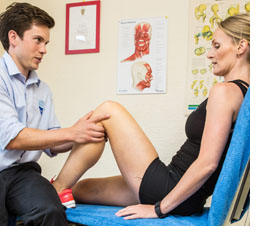Muscles/tendons/ligaments
 Muscle strain
Muscle strain
Physiotherapists are mainly concerned with “skeletal muscles”, which are anchored to bone via tendons. When a muscle is put under more stress than it can tolerate, its fibres lose their integrity and the muscle becomes strained. As with tendon and ligament injuries, such stress can result in a total rupture.
Appropriate early management is essential for all soft tissue injuries, including muscle strains. Managed correctly, inflammation can be controlled and scar tissue build-up limited, in order to produce a strong, flexible and functional healing process.
Consult Arches Physiotherapy for the best advice on treating and following up a muscle injury.
ask us | T: 02890 672340 | book online
Tendon strains
Tendons hold muscles to bones. They transfer large forces from the muscle to the bone in order to create movement of a joint. Tendons also play a large role in our understanding where our body is in space.
They are made of the same material as ligaments – collagen – and are extremely strong, but also flexible. This makes them extremely efficient at transferring force and absorbing load.
When the tendon’s tolerance to load is exceeded then the tendon becomes injured or “strained”. This can range from a few strained collagen fibres – a minor injury – to every collagen fibre and therefore a total rupture.
If totally ruptured, certain tendons require emergency surgery. If you suspect you have such an injury, seek medical attention immediately, as delaying can result in significant, long-term reduction in the function of the joint and the limb affected. Physiotherapy is an important factor in an effective and efficient recovery process.
ask us | T: 02890 672340 | book online
Ligament sprains
Physiotherapy after a ligament sprain brings important benefits, from improved speed of recovery to reduced recurrence rates. At Arches, we have the tools to help you return to normal, and stay that way.
Ligaments hold bones to other bones. They provide mechanical stability to joints and contribute to our awareness of where a body part is in relation to other body parts and to the external environment (proprioception).
They are strong, but also slightly elastic, so can stretch before returning to normal length when the joint that they are stabilising returns to its resting position. However, when they stretch too far, an injury or “sprain” occurs, as the collagen fibres that make up the ligament cannot bear the load demanded of them.
Commonly, ligament sprains in the knee and ankle occur with twisting forces. Symptoms include swelling and pain around the joint and feelings of instability. It can be hard to put weight through a recently sprained joint. It is often useful to get an X-ray after a sprained ligament, as many of the signs and clinical features are similar to that of a fracture.
Seeking physiotherapy to speed and enhance the healing process is highly recommended.
ask us | T: 02890 672340 | book online
